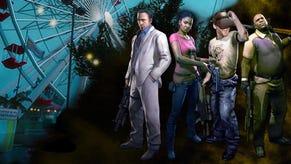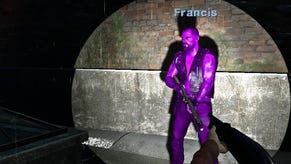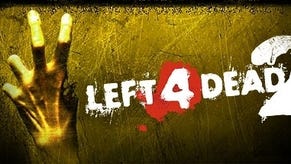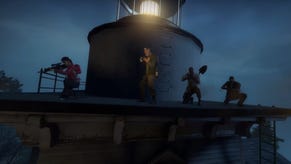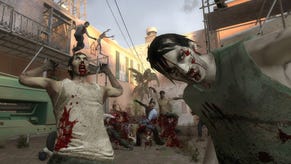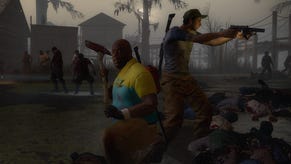Left 4 Dead 2: Specials, Weapons and Tactics
Out of the frying pan and into the face.
It's early September in Seattle, Washington, and on every television channel, the Republican Party and the health insurance lobby are teaming up to murder the plucky British NHS in wall-to-wall attack adverts. Meanwhile, on a series of HD displays in Valve's Bellevue offices, Tom Bramwell, Eurogamer editor, and Chet Faliszek ("F as in Frank, A-L-I-S, Z as in Zebra, E-K," he says with a practiced efficiency), ostensibly a writer at Valve although I suspect he does a lot more besides, are teaming up all by themselves to murder waves of infected, while I wait patiently for my rescue behind a locked door somewhere in the distance, having been covered in bright green acidic goop by a Spitter, and then ridden off a cliff rather abruptly by a Jockey.
Left 4 Dead 2's new specials don't disappoint, and they don't waste much time in thinning the ranks of the survivors. In fact, the whole sorry situation serves as a reminder that, while some rather fundamental changes have been made during Valve's second zombie apocalypse, many things (me stuck in the closet, Tom toying with whether to let me out again because I'll probably only cause more damage to my own team) have remained the same.
It was always going to be a tricky job building on Left 4 Dead's framework. Not only did Valve's blue-collar splatterhouse get so much right in the first wave of its murderous infection, it did so in such an economical manner: the weapons and enemies were pared down to the most entertaining of bare minimums, while the handful of solid campaigns were designed to be swiftly memorised and then exploited, both by the game's own fanbase, and the developer's now legendary AI director, the most charismatic string of code since Nintendo managed to get the fireworks to go off at the end of each Super Mario stage.

Left 4 Dead may have broken its levels up into grindhouse B-movies, and announced the arrival of its set-pieces with brilliantly heavy-handed orchestral swells and squawks, but deep down this wasn't a game that aspired to cinema as much as it did to the world of sports, as a well-balanced team activity with a grim understanding that real fun is as likely to come from restrictions as it is from freedom. And, after all, sports tend not behave nicely when there are sudden changes to the underlying rules. (I'm not counting Formula One, here.)
So Valve has been canny with its tinkering. As we play through sections of both the Swamp Fever and Dark Carnival campaigns (detailed by Tom in greater detail in his alternative hands-on), besides discovering that Faliszek is a master of the short-form morale booster - typical examples include, "Eugh, I don't think there's a lot of hope now," and "You guys really don't fill me with confidence," - we also encounter a game where the pace is as brisk and snappy as it ever was, but which is now also capable of springing delightfully horrible surprises on you at every turn, whether it's a new weapon to mess about with, or a fresh special infected giggling and moaning in the darkness, itching to do you harm.
And those specials are clearly the standout addition this time around. All three newcomers are distinct and gleefully terrifying, and all three add regular bursts of chaos to the endless waves of the horde, while fitting into the line-up so seamlessly they feel like they could have been there from day one. The Spitter, who lobs pools of bright green acidic gunk around the map, damaging anyone who strays into it, and the Charger, a lop-sided hulk who blasts through at regular intervals, grabbing a team member and then running off, before pounding them endlessly against the ground, have already been revealed, but we're getting a chance to see the third and final addition, the Jockey, for the very first time. Announcing himself with a sound that hovers uneasily between an asthmatic chuckle and a wretched, ragged-throated heaving, this saggy, balding creep wearing the remains of a shredded Die Hard vest leaps unexpectedly onto a player's head before steering them off into the distance or over a cliff, seemingly unpredictably.

Except it's probably not as unpredictable as it initially sounds. One of the more interesting underground tweaks to Left 4 Dead 2 is that the specials are now genuinely aware of each others' presences, much as you are in Versus mode, meaning they'll regularly combine their strategies for maximum destructive effect. And so the Jockey becomes the natural ally of the Spitter, waiting until there's a rich pool of toxic goo nearby before powering you helplessly into it. Or maybe he'll ride you out of your carefully chosen safe spot and right into a Tank. Or maybe a Tank will knock you down to allow a Spitter to cover you in acid, all the better to take out any team-mate who tries to revive you.
Valve is fairly open about the fact that one of the primary uses for the new specials is to close any remaining strategic loopholes players may have been exploiting - which is why the Spitter is such a powerful anti-camping weapon, and the Charger can bust up highly-organised teams who work too tightly together, pulling them apart, and running off with crucial members - and yet, in the interactions between them all, the development team's created something much more promising than an underhand balancing patch: they've built a far more tactical enemy, with a wealth of new malicious tag-team options open to them. Throw in tweaked behaviours for some of the existing specials - the Witch can now wander around daylight maps, becoming an even more disastrous presence, for example - and you've got something fresh and unpredictable at the heart of an otherwise pleasantly familiar experience.


